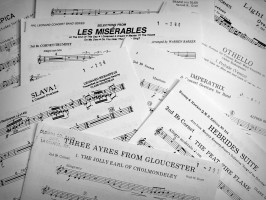For many years I have been inundated with questions mostly about copyright. Lately at conferences and in consultations, the overwhelming majority of questions I receive are about music licensing. “How do I get my songs licensed?” is by far the most common asked by artists. It’s an extremely complicated question to answer fully in this space. However, there are solid steps that artists can take before the next project is recorded, that will greatly increase the odds of a placement or license in 2011.

In an effort to illustrate what you need to pay attention to (and why), here are some real-world examples of what our licensing office is looking for on a typical day. I am working three client briefs: A) is for a cruise line ad spot, B) is for a primetime television show on a new cable network and C) is for a pre-cleared version of “Take Me Out to the Ballgame” to be used for an MLB property.
A) Notes: a song with a luxurious feel, female vocals and possibly foreign language lyrics (French or Spanish). Vocals down mix, instrumentals ok.
B) Notes: uplifting, edgy, indie. BPM over 100, :30-:60 sec of chorus. Keywords: night, stars, brand new, shine.
C) Notes: song is public domain, please keep to original lyrics, must be new master recording.
Each of these licenses will be pitched and filled within 48 hours and will pay in the tens of thousands of dollars for a national placement, plus royalties for public performances paid by your PRO. Needless to say, that is worth putting some extra effort into.
After seeing those notes, does your band or project fit any of these specific requirements? Maybe not (they are pretty specific, after all), but regardless of your style or genre, here are five things to consider BEFORE recording your next project.
1) Before you agree on the price of a recording project, make sure you request an instrumental mix and, if budget permits, a “vocals down mix” in addition to the final mixes. This gives you double the songs and the space to make slight changes if they are needed. If you have instrumental mixes, you can drop in new choruses or even change existing words to fit the licensing project.
2) During your session, make notes of all of your tempos (in BPMs) and track the times of the finished choruses and verses. You can also do this in iTunes to your older songs using various applications, such as those available on beatunes.com
3) Master your recordings professionally. You don’t see that in the notes on the pitches above because it is a given. I do not know a licensor that ever pitches demos and I have never heard of one placed. If there is ever a question of whether to send a hot track versus a lower volume or subdued track, ALWAYS send the hot one.
4) If you are really serious about getting a lot of music licensed, you need to consider some sort of home setup. GarageBand can work, obviously, Pro Tools and Logic are your best bets and a good microphone will be invaluable. With a small setup, you could crank out a version of “Take Me Out…” and you would forever have that version to pitch.
5) Remember to register your song with your PRO completely and “tag” your music as you save it with lyrics and contact information, including any publishers and songwriters. This makes cross-referencing PROs for music cue sheets a lot easier, which means you will actually get paid.
In future articles, we will explore more in-depth tactics to better pitch your music, as well as covering the places to do so.
–Michael St. James is a songwriter, performer, producer, music publisher and music industry speaker and consultant. He’s the author of the book The New Music Business Model 2.0 and creative director of Stjamesmedia, LLC.
